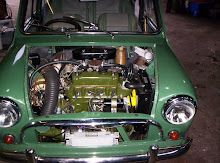If the warning light provided on later models (see pages 4 and 5) glows before the recommended mileage has elapsed, the filter should be changed within the next 300 miles.
If an early filter change has been carried out, however, and only a thousand miles or so have elapsed before the normal 6,000-mile service falls due, there will be no need to change the filter again at this service; it can be left to run its full 6,000 miles, unless the warning lamp lights up after a shorter period.
Normally, the filter casing is removed by working from beneath the car, but it is easier to remove the radiator grille. This is necessary, in any case, when changing the horizontally-mounted filter on automatic-transmission models. Shops which sell Mini accessories can usually supply two special retaining nuts which allow the grilles on most models to be removed quickly and easily a worthwhile modification for the owner who does his own servicing, as it also makes it easier to work on the ignition distributor.
Before removing the oil filter, clean the exterior of the casing as thoroughly as possible before removing the central retaining bolt. The filter retaining bolt can then be unscrewed, holding a tin beneath it to catch the oil which will drain from the filter as the bolt is withdrawn. The casing can then be removed.
The new element will be supplied complete with new sealing washers. Although most instruction manuals, and the leaflet enclosed with the element, recommend that the sealing washer in the casting, against which the upper edge of the filter bowl seats, should be renewed, it is a tricky job to fit the new washer evenly into its groove.
If the old washer appears to be in good condition, therefore, it is best to leave well alone. Only if an oil leak becomes apparent when the filter is reassembled and this cannot be corrected by slackening the bolt and repositioning the filter, should the washer be renewed. To do this, the simplest plan is to remove the filter bracket from the crankcase by undoing the oil pipe connexion and the two retaining screws. If the gasket between the flange of the bracket and the crankcase is damaged, a new gasket should be fitted at this point.
Assuming that a straightforward exchange of the filter element has been carried out, however, the filter bowl should be thoroughly cleaned before the new element is inserted and the small felt washer must be positioned between the element pressure plate and the metal washer above the pressure spring. To ensure correct oil filtration it is particularly important that this washer should be in good condition and a snug fit on the central securing bolt. After the bowl has been manoeuvred into position beneath the bracket and the central securing bolt inserted, hold the head of thebolt up against the bowl and fill the bowl with oil to ensure that oil will reach the bearings as soon as the engine starts. For the same reason, do not operate the starter while the filter is off or the sump empty, as this will empty the oil pump and the oilways, possibly resulting in considerable delay in building up pressure when the engine is restarted.
As soon as the engine is running, examine the filter for leakage. A very pronounced oil leak will occur if the bowl is slightly displaced and does not seat squarely on the sealing ring.
Sunday, 18 October 2009
Changing the Oil Filter
Labels: changing, mini car care, oil filter
Posted by Info Mini Cars at 04:13
Subscribe to:
Post Comments (Atom)


0 comments:
Post a Comment